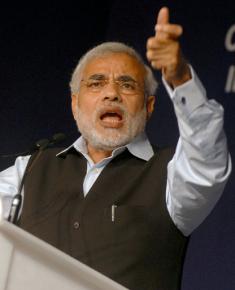Confronting a Hindu fascist
As a minister in the Indian state of Gujarat, Narendra Modi played a central role in anti-Muslim violence, explain and .
THE WHARTON India Economic Forum at the University of Pennsylvania disinvited Narendra Modi, chief minister of the Indian state of Gujarat, after students and faculty members submitted a petition opposing the right-wing politician's presence. Modi has been implicated in the 2002 state-sponsored pogrom that led to the deaths of hundreds of Muslims.
Substantial pressure from the alumni and many others associated with Wharton contributed to the invitation being revoked, according to Ania Loomba, an English professor and one of the organizers of the petition drive. As the petition states:
This is the same politician who was refused a diplomatic visa by the United States State Department on March 18, 2005, on the grounds that he, as Chief Minister, did nothing to prevent a series of orchestrated riots that targeted Muslims in Gujarat. The most conservative estimates are that over a thousand people, mostly Muslims, died in those riots. Thousands more were forced to leave their homes and businesses. Human Rights Watch (among other international and Indian bodies) showed that politicians and the police in the state abetted the slaughter and displacement of Muslim Gujaratis.

In solidarity with the actions at Penn, students and faculty at universities ranging from Ohio State to the University of Texas-Austin and the University of California-Berkeley have planned screenings of Rakesh Sharma's documentary Final Solution, about the 2002 pogrom against Gujarati Muslims.
Despite his atrocious human rights record, Modi's political stock is on the rise. Corporate-owned media in India and increasingly in the West have showered praise on Modi and talked about Gujarat as a "model" and even a "miracle" in terms of economic development. Of course, it helps to have the Washington-based lobbyist firm APCO dedicated to the project of sanitizing Modi's image and covering up his government's complicity in the massacre--at a cost of $25,000 per month.
Modi's defenders try to deflect his critics by changing the subject to Gujarat's torrid economic growth and claiming Modi's right to "free speech," but a figure who incites murder should face protests wherever he shows his face. And "strong economic growth" cannot be allowed to bury Modi's complicity in this campaign of ethnic cleansing.
ON THE morning of February 27, 2002, Hindu pilgrims and raucous volunteers of the Sangh Parivar (a family of organizations of the Hindu nationalist right) known as kar sevaks arrived aboard the Sabarmati Express train at Godhra station. Kar sevaks got off the train during its brief stop and started shouting religious slogans and molested burkha-clad Muslim women. An irate crowd pelted the pilgrims with stones.
Within a few minutes after the train left the station, a fire broke out that burned down a coach and resulted in 59 deaths, most of them Hindu pilgrims. This provided the trigger for the pogrom that followed.
The popular narrative that this was a pre-planned attack on Hindus by Muslims is doubtful at best, and there is evidence to suggest that the fire started from inside the train. Nevertheless, in the three days after the Godhra train burning, there was an effort to ethnically cleanse the Muslim population in Gujarat.
Sixteen of 24 districts were affected by communal riots where Hindus massacred Muslims. Some of the violence took place hundreds of miles away from Godhra, belying the idea that the riots were a spontaneous reaction. The official estimates claim that 790 Muslims and 254 Hindus died, but the unofficial estimates claim that the death toll exceeded 2,000, of which the majority were Muslims.
The violence perpetrated on the Muslims was pre-planned, and Godhra simply provided a trigger. Communalism Combat, a journal edited by civil rights activist Teesta Setalvad, had issued prior warnings about the looming danger of communal violence. As historian Tanika Sarkar points out:
Each individual feature of Gujarat has been anticipated and experimented with since the Ramjanmabhoomi (Birthplace of God Ram) movement began: in Meerut, Maliana, Bhagalpur, at Ayodhya, Mumbai, Surat, Bhopal, at Manoharpur in Orissa and at countless other places.
The Hindu mobs had computer printouts of voter registration documents and knew addresses of Muslim-owned properties. Muslim-owned shops were looted and vandalized and shops partially owned by Muslims were also looted and damaged, indicating that preparation had started long before the Godhra incident. As Smrita Narula suggests:
What happened in Gujarat was not a spontaneous uprising, it was a carefully orchestrated attack against Muslims. The attacks were planned in advance and organized with extensive participation of the police and state government officials.
The police aided and abetted the mob in carrying out the violence. In some cases, they were silent spectators and did not interfere while the saffron-clad Hindu mobs proceeded to kill Muslims with swords and sticks. On other occasions, they abetted by masquerading as protectors, only to lead hapless Muslims straight toward a waiting mob.
Ambulances were allowed to pass once they yelled Jai Shri Ram (meaning Hail Ram, indicating the victim is a Hindu). First Information Reports (FIR), the initial complaint made about a crime, were often denied or not recorded. Sometimes the police entered FIRs collectively and did not allow individual names, despite the victims claiming to have recognized the perpetrators. The state tried to cover up its complicity and the role of the Sangh Parivar.
AS TANIKA Sarkar writes, words like "communal violence" and "massacre" have been too "domesticated," to be used to describe the depravity of the violence. Women in particular were made targets of violence and revenge, according to philosopher Martha Nussbaum:
Particularly striking were the mass rapes and mutilations of women. The typical tactic was first to rape or gang-rape the woman, then to torture her, and then to set her on fire and kill her. Although the fact that most of the dead were incinerated makes a precise sex count of the bodies impossible, one mass grave that was discovered contained more than half female bodies.
According to Human Rights Watch, "In some cases, pregnant women had their bellies cut open and their fetuses pulled out and hacked or burned before the women were killed."
More than 200,000 people were internally displaced. Muslims fled riot-prone neighborhoods in search of shelter from the unspeakable violence. The state turned a blind eye to survivors and the relief camps organized for them. Not only did the state provide inadequate relief, it refused to acknowledge the relief camps set up by international organizations and Indian nongovernmental organizations that did make efforts to address the humanitarian crisis. It has also been reported that in some cases, the relief camps were organized near graveyards, and some victims even had to sleep between graves.
These atrocities didn't stop Modi from declaring--even as the scale of violence was at its most intense--that the "people of Gujarat have shown remarkable restraint under grave provocation," according to the HRW report. Indian Prime Minister of India Atal Bihari Vajpayee, himself a member of the Hindu nationalist Bhartiya Janata Party (BJP), said in April 2002:
[W]herever Muslims are living, they don't want to live in harmony. They don't mix with the society. They are not interested in living in peace...We don't need lessons in secularism from anyone. India was secular even before the Muslims and Christians came.
MODI'S RIGHT-wing boosters today talk about Gujarat's rapid economic growth, its efficient administration and the amount of investment generated. The elite of Indian capitalism have credited Modi with creating a "business-friendly environment," which has made it easier for them to set up exploitative and environmentally destructive enterprises.
The Economist magazine joined the chorus. Perhaps this line is all that's necessary to summarize its attitude: "So many things work properly in Gujarat that it hardly feels like India."
Modi is not shy about expressing hyperbolic admiration for his own "accomplishments," calling Gujarat a "ray of hope in this period of gloom and darkness" in India.
Judged by its own standards, however, Gujarat's economic performance falls short of anything resembling a miracle. Contrary to the hype, other states have actually outperformed Gujarat in terms of growth rate. The Centre for Monitoring the Indian Economy has exposed the disconnect between official claims of major investments attracted through vibrant Gujarat investors' summits and the lack of actual projects moving forward on the ground.
Additionally, Gujarat's debt burden has tripled since Modi came to power in 2001, an increase that is definitely not a result of much-needed social welfare spending. Income-tax investigations revealed large amounts of undisclosed and unaccounted income from real-estate developers and other entities, with the average amount uncovered per search much higher than the national average.
The Comptroller and Auditor General of India has called attention to "undue" favors provided to corporations by the Gujarat state government and $3.1 billion in losses as a result of irregularities and corruption.
More importantly, Gujarat does not fare well according to many measures of social progress. According to the 2011 Indian Human Development, "Among the industrial high per capita income states, Gujarat fares the worst in terms of overall hunger and malnutrition."
In areas like child malnutrition, anemia among women and children and the hunger index, the state's performance is worse than some that are much poorer. Also, Gujarat is among the lowest spenders on education as a percentage of state domestic product and is one of four states in which more than 40 per cent of Muslim females between 6 and 17 years of age are out of school.
Additionally, Muslims in Gujarat experience lower workforce participation, are being left behind in education, and have much higher urban and rural poverty levels compared to Hindus across caste, according to a study by Abusaleh Shariff, an economist with the National Council for Applied Economic Research.
Modi's unfiltered explanation for the malnutrition and anemia levels suggests that even APCO's carefully coordinated p.r. efforts can fall short at times. From his standpoint, the prevalence of vegetarianism in Gujarat--along with a middle-class orientation that makes women more "beauty conscious than health conscious"--explains the high levels of malnutrition.
Nevertheless, Modi enjoys support among sizable segments of Indian communities living abroad. This is in part due to the inroads made by the Hindu right in the U.S. and United Kingdom. They have extended the network of fascism that is well known in India, which includes Hindu Swayamsevak Sangh (HSS), Vishwa Hindu Parishad-America (VHP-A) and Overseas Friends of Bharitya Janata Party (OFBJP).
These formations have succeeded in establishing local chapters and student groups--such as Hindu Students Councils, which is a VHP-A affiliate--on college campuses that can serve as a conduit for money that in turn fund their Indian parent organizations. Other organizations such as the Hindu America Foundation, Hindu Education Foundation (an HSS affiliate) and the Vedic Foundation gained prominence in a campaign to change content in California school textbooks regarding the status of women and the origins of the caste system in Hinduism.
These groups have appealed to the idea of "enhancing cultural awareness" to advance their Hindu supremacism and Islamophobia. However, the successful opposition to Modi's scheduled speech at the University of Pennsylvania points to voices of resistance in South Asian communities and beyond that reject the Hindu nationalist agenda and its commitment to religious domination. Forces on the left need to challenge globalized right-wing movements like Hindu nationalism with a politics of internationalism and real transnational linkages.


